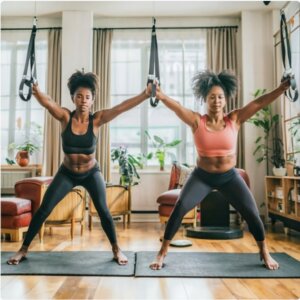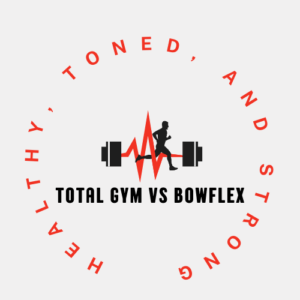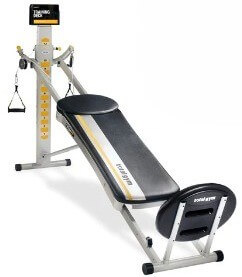Beginner’s Guide, Stress Relief, and At-Home Workouts
If you’re looking to switch up your yoga routine, you may want to consider trying Yoga Trx flow. This unique style of yoga incorporates the use of TRX suspension straps, which can help to challenge your balance and build strength. Whether you’re a beginner or an experienced yogi, TRX yoga flow can offer a fresh and exciting way to practice.
One of the bigger benefits is its ability to provide a full-body workout. By using the suspension straps, you can engage your core and upper body muscles in new ways, while also improving your flexibility and balance. Additionally, can be a great way to relieve stress and tension, as the movements are designed to help you connect with your breath and find a sense of calm.
If you’re curious about TRX yoga flow, you may be wondering how it differs from traditional yoga and why it is a very great approach vs classic gym like BowFlex or Total Gym workout. While both styles share some similarities, TRX yoga flow tends to be more dynamic and challenging. By incorporating the suspension straps, you can add an extra level of intensity to your practice, which can help to build strength and endurance. Plus can be done at home, making it a convenient option for those who prefer to exercise in the comfort of their own space.

TRX Yoga Flow Basics
If you are a beginner and want to try a new workout, TRX Yoga Flow can be a great option. This workout combines the benefits of TRX suspension training with the practice of yoga, resulting in a unique and challenging workout.
What Is TRX Yoga Flow?
TRX Yoga Flow is a workout that combines TRX suspension trainers with yoga poses. The TRX suspension trainer is a piece of equipment that uses your body weight as resistance, allowing you to perform a variety of exercises. In this excellent workout, you use the suspension trainer to help you get deeper into yoga poses, while also building strength and stability.
Yoga Trx Flow Benefits
TRX Yoga Flow offers numerous benefits, including:
- Improved flexibility: By using the TRX suspension trainer, you can get deeper into yoga poses and improve your flexibility.
- Increased strength: TRX Yoga Flow is a full-body workout that can help you build strength and stability.
- Stress relief: The combination of yoga and TRX suspension training can help reduce stress and improve your overall well-being.
- Convenience: Because we can do it at home or in a gym, making it a convenient workout option.
- Variety: It is the single one that combines two different workouts, providing a unique and challenging experience.
Overall, TRX Yoga Flow can be a great workout option for beginners who want to try something new and challenging. By combining TRX suspension training with yoga, you can improve your flexibility, build strength, and reduce stress, all in one workout.
TRX Yoga Flow for Beginners
If you’re new to TRX yoga flow, it’s important to start with the basics and build your way up to more advanced poses. This is a great combination of traditional yoga poses and TRX suspension training, which uses straps to create resistance and challenge your muscles. This unique workout can help improve your strength, flexibility, and balance, while also providing stress relief.
Getting Started with TRX Yoga Flow
Before you begin your workout, it’s important to set up your straps properly. Make sure the straps are securely anchored to a stable surface, such as a door or wall mount. Adjust the straps to the appropriate length for your height, and always check that the straps are secure before starting your workout.
It’s also important to wear comfortable clothing that allows you to move freely, and to have a yoga mat or other soft surface to practice on. Start with a warm-up to get your muscles ready for the workout, such as a few minutes of light cardio or dynamic stretching.
Basic TRX Yoga Poses for Beginners
Here are a few basic TRX yoga poses to get you started:
- TRX Squat: Stand facing the anchor point with your feet hip-width apart and your hands on the straps. Lower into a squat, keeping your knees in line with your toes. Push back up to standing.
- TRX Plank: Place your feet in the straps and come into a plank position with your hands on the ground. Engage your core and hold for several breaths.
- TRX Warrior II: Stand facing away from the anchor point with your feet wide apart. Turn your left foot out and your right foot in. Reach your arms out to the sides and bend your left knee, keeping it in line with your ankle. Hold for several breaths before switching sides.
Remember to listen to your body and modify or skip any poses that don’t feel comfortable or safe for you. With practice, you can gradually increase the intensity and complexity of your flow workout.
TRX Yoga Flow Workout
If you’re looking for a challenging and dynamic yoga workout, TRX Yoga Flow might be just what you need. This fusion of yoga and suspension training is a great way to build strength, flexibility, and balance while getting a full-body workout. Here are some tips for designing your own routine and a sample workout to get you started.
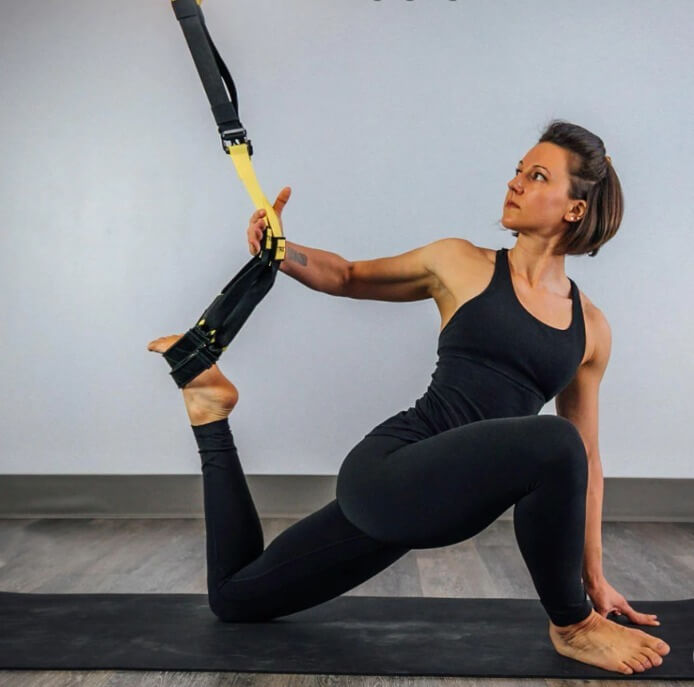
Designing Your TRX Yoga Flow Routine
When designing your TRX Yoga Flow routine, it’s important to consider your fitness level and goals. If you’re new to yoga or TRX, start with basic poses and exercises and gradually increase the intensity and difficulty as you get stronger and more comfortable with the movements. Here are some basic principles to keep in mind:
- Warm up: Start with some gentle stretching and mobility exercises to warm up your muscles and joints.
- Focus on form: Proper form is crucial for getting the most out of your TRX Yoga Flow workout and reducing the risk of injury. Take your time to learn each pose and exercise and focus on maintaining good form throughout.
- Include a variety of poses and movements: TRX Yoga Flow is all about combining yoga poses with suspension training movements to create a dynamic and challenging workout. Mix up your routine with different poses, transitions, and exercises to keep things interesting and challenging.
- Cool down and stretch: Finish your workout with some gentle stretching and relaxation exercises to help your body recover and reduce muscle soreness.
Sample TRX Yoga Flow Workout
Here’s a sample TRX Yoga Flow workout to get you started:
| Exercise | Reps/Time |
|---|---|
| Warm up: Cat-Cow Stretch | 10 reps |
| Warm up: Downward-Facing Dog | 30 seconds |
| Warm up: Sun Salutation A | 5 reps |
| TRX Yoga Flow: Warrior 1 | 10 reps |
| TRX Yoga Flow: Warrior 2 | 10 reps |
| TRX Yoga Flow: Tree Pose | 10 reps |
| TRX Yoga Flow: Side Plank | 10 reps |
| TRX Yoga Flow: Crow Pose | 10 reps |
| Cool down: Child’s Pose | 30 seconds |
| Cool down: Seated Forward Fold | 30 seconds |
| Cool down: Savasana | 2-5 minutes |
Remember to modify the exercises and poses as needed to suit your fitness level and goals. With regular practice, TRX Yoga Flow can help you build strength, flexibility, and balance while reducing stress and improving your overall well-being.
TRX Yoga Flow for Stress Relief
If you’re feeling stressed and overwhelmed, practicing TRX yoga flow can help you calm your mind and soothe your body. This low-impact workout combines yoga poses with TRX suspension training, allowing you to stretch and strengthen your muscles while also improving your balance and flexibility. Here are some tips for incorporating TRX yoga flow into your stress-relief routine.
TRX Yoga Poses for Relaxation
TRX yoga poses are designed to help you release tension in your body and calm your mind. Here are some of the best TRX yoga poses for relaxation:
- TRX Forward Fold: Stand facing the TRX straps, holding onto the handles with both hands. Walk your feet back until your body is at a 45-degree angle. Allow your head and neck to relax, and hold the pose for several breaths.
- TRX Hip Opener: Stand facing away from the TRX straps, holding onto the handles with both hands. Lift one foot off the ground and place it in the TRX strap. Slowly lower your body down into a lunge, keeping your back leg straight. Hold the pose for several breaths, then switch sides.
- TRX Child’s Pose: Kneel on the ground facing the TRX straps, holding onto the handles with both hands. Walk your hands forward until your forehead is resting on the ground. Relax your arms and shoulders, and hold the pose for several breaths.
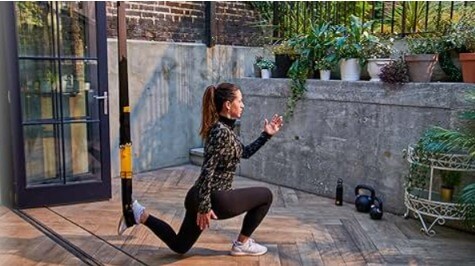
Incorporating Mindfulness in TRX Yoga Flow
Mindfulness is an essential part of any stress-relief practice. By focusing on your breath and staying present in the moment, you can quiet your mind and reduce your stress levels. Here are some tips for incorporating mindfulness into your TRX yoga flow:
- Focus on Your Breath: As you move through each TRX yoga pose, focus on your breath. Inhale deeply through your nose, and exhale slowly through your mouth. Try to make your breaths as deep and slow as possible.
- Stay Present in the Moment: Instead of letting your mind wander, try to stay present in the moment. Focus on the sensations in your body, and pay attention to how each TRX yoga pose feels.
- Set an Intention: Before you begin your workout, set an intention for your practice. This can be anything from “I am calm and relaxed” to “I am strong and resilient.” Repeat your intention to yourself throughout your practice to help you stay focused and centered.
By incorporating these TRX yoga flow poses and mindfulness techniques into your stress-relief routine, you can reduce your stress levels and improve your overall well-being.
TRX Yoga Flow vs Regular Yoga
Comparing TRX Yoga Flow to Traditional Yoga
TRX Yoga Flow is a fusion of traditional yoga and suspension training using the TRX equipment. Unlike traditional yoga, TRX Yoga Flow incorporates the use of straps and handles to support and challenge the body in different ways. While traditional yoga emphasizes on holding static poses for extended periods, TRX Yoga Flow focuses on dynamic movements that engage the entire body.
TRX Yoga Flow also offers a variety of modifications that can be used to adjust the intensity of the workout, making it suitable for beginners and advanced practitioners alike. Traditional yoga may not offer as many modifications, which can make it challenging for beginners to keep up with the practice.
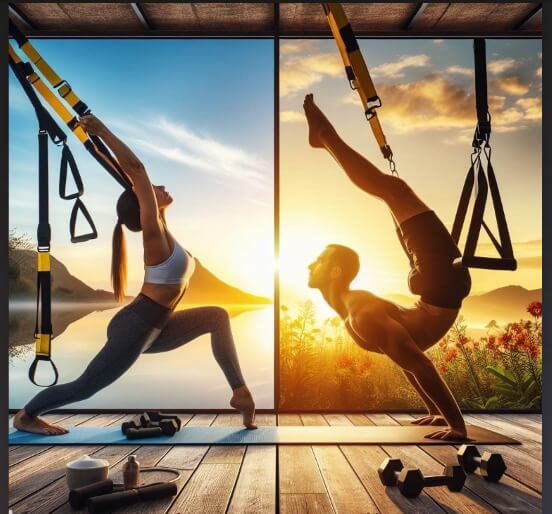
Advantages of TRX Yoga Over Regular Yoga
One big advantage of TRX Yoga Flow over traditional yoga is that it provides a full-body workout that helps to build strength, flexibility, and balance simultaneously. The use of suspension training also allows for a greater range of motion, which can help to improve overall mobility.
TRX Yoga Flow offers another advantage by allowing individuals to easily do it at home with minimal equipment. Unlike traditional yoga, which may require a mat and other props, TRX Yoga Flow only requires the TRX equipment, making it a convenient option for those who prefer to workout at home.
In conclusion, while traditional yoga and TRX Yoga Flow both offer unique benefits, TRX Yoga Flow provides a more dynamic and challenging workout that can help to improve overall fitness and mobility.
TRX Yoga Flow at Home
If you are looking for a way to practice yoga at home with a bit of added challenge, TRX Yoga Flow might be just what you need. With the help of suspension straps, you can deepen your yoga practice and build strength and flexibility at the same time. Here are some tips for setting up your space and practicing safely.
Setting Up Your Space for TRX Yoga Flow
Before you start your TRX Yoga Flow practice at home, make sure you have enough space to move around freely. Clear your floor of any obstacles and make sure there is enough room for you to stretch your arms and legs in all directions. If you have a yoga mat, use it to provide some cushioning and grip.
You will also need to set up your TRX suspension straps. Find a sturdy anchor point, such as a door frame or a tree branch, and attach the straps securely. Make sure the straps are at the appropriate length for your height and the exercises you will be doing.
Tips for Practicing TRX Yoga Flow Safely at Home
As with any physical activity, it’s important to practice TRX Yoga Flow safely to avoid injury. Here are some tips to keep in mind:
- Start with the basics: If you are new to TRX Yoga Flow, start with the basic poses and exercises before moving on to more advanced ones. This will help you build strength and flexibility gradually and avoid injury.
- Listen to your body: Pay attention to how your body feels during each pose and exercise. If something feels uncomfortable or painful, adjust your position or stop the exercise altogether.
- Warm up and cool down: Before you start your TRX Yoga Flow practice, warm up your muscles with some gentle stretches. After your practice, cool down with some more stretches and relaxation poses.
- Use proper form: Make sure you are using proper form for each pose and exercise to avoid strain on your joints and muscles. If you’re not sure how to do a pose correctly, consult a yoga teacher or watch instructional videos online.
- Stay hydrated: Drink plenty of water before, during, and after your TRX Yoga Flow practice to stay hydrated.
With these tips in mind, you can enjoy the benefits of TRX Yoga Flow in the comfort of your own home.

